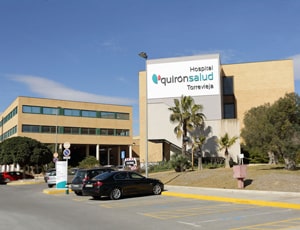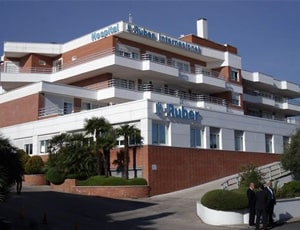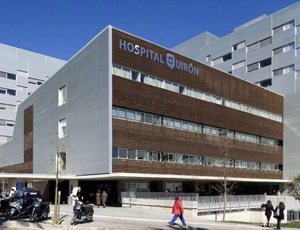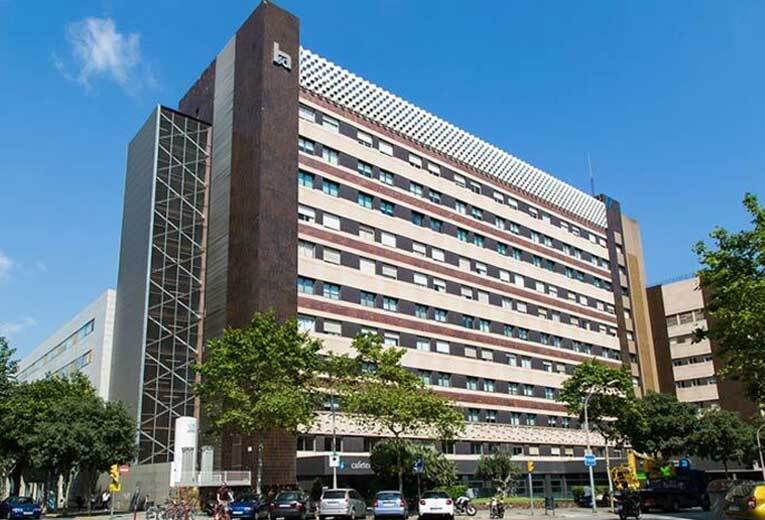Treatment cost

Quironsalud Torrevieja Hospital located in Torrevieja (Alicante), Spain is accredited by ISO. Also listed below are some of the most prominent infrastructural details:


The Hospital has a wide architectural structure that consists of-

Apart from in-detail treatment procedures available, Hospital Quirnsalud Barcelona located in Barcelona, Spain has a wide variety of facilities available for International Patients. Some of the facilities which are provided by them are Accommodation, Airport Transfer, Choice of Meals, Interpreter, SIM, TV inside room. Also listed below are some of the most prominent infrastructural details:

The cost for Breast Cancer Treatment ranges from USD 10540 - 12460 in Sagrat Cor University Hospital
The Hospital is an amalgamation of a group of buildings located in the Eixample Left of Barcelona, ??between Paris, Viladomat, and London streets. It has a capacity of 350 adjustable beds and first-class hotel-like services inpatient rooms. Currently, it has a workforce of about 1100 Healthcare Professionals.
In order to treat patients with intensive care, the Hospital has 10 beds in its ICU for critically ill patients.
The Hospital has launched a few more things to improve customers’ services- 4 new Operating Rooms and a New Diagnostic Imaging Service.
Other Services
Types of Room
Double Rooms, Double Rooms for Individual Use, and Single Rooms; equipped with an easy-to-use electrical movement control system and a nursing call/warning system, located at the head of the bed, a sofa-bed for the companion, and a bathroom with a shower. They are also equipped with television and telephone.
A cafeteria/Restaurant is also available for the patients or visitors.
SPECIALITIES
FACILITIES & AMENITIES
Breast cancer is a type of cancer that originates in the cells of the breast. While it can occur in men as well, it is far more prevalent in women.
Following skin cancer, breast cancer stands as the second most frequently diagnosed cancer among women in the United States. However, it's crucial to recognize that breast cancer is not exclusive to women, as everyone is born with some breast tissue, making it a condition that can affect individuals of any gender.
Improved breast cancer screening techniques enable healthcare providers to detect the presence of breast cancer at an earlier stage. Early cancer detection greatly increases the chances of effective therapy and recovery.
The exact reason that causes breast cancer is unclear, even though every eighth woman suffers from it. However, several factors have been associated with the development of breast cancer. Some of the breast cancer risk factors include:
The risk of breast cancer naturally increases as women age. The risk is also higher in women who have a family history of breast or ovarian cancer, possess BRCA1 and BRCA2 genes, or have had their periods before the age of 12.
The main types of breast cancer are based on where the cancer begins, whether it's in the ducts or lobules of the breast, and whether it has spread beyond its original location. The two broad categories are in situ (confined to the site of origin) and invasive (has spread beyond the original location). Here are some common types:
Most commonly, as a part of treatment for breast cancer, surgery is conducted to remove the cancerous lump or growth from the breasts. Depending on the extent of the cancer and its stage, surgery may be accompanied by another form of treatment as well, which is conducted either before or after the surgery.
The doctor decides upon a breast cancer treatment plan that is most suitable for the patient. The decision may depend upon the extent of spread, the overall health of the patient, the stage, and the type of breast cancer (inflammatory, cancer during pregnancy, lobular carcinoma, ductal carcinoma, and invasive breast cancer).
The team that conducts breast cancer treatment includes a surgeon, a medical oncologist, and a radiation oncologist. The different breast cancer treatment options are divided into two types:
Local Treatment: This type of treatment is localized, that is, it is only used to treat one specific location or primary site affected by cancer. It does not have any impact on the rest of the body.
The following are the two types of local treatment:
The radiation can either be delivered externally or by placing a small radioactive pallet in the affected area internally. The latter form of radiation therapy is known as brachytherapy.
II. Systemic Treatment: This type of treatment involves the use of drugs that can be administered either orally or intravenously. The choice of drugs depends on the type of systemic treatment opted for, which, in turn, is dependent upon the extent and the type of cancer.
The recovery journey following breast cancer treatment, though generally less painful and traumatic than some other critical cancers, brings about certain adjustments for patients. These changes encompass various aspects of their physical and emotional well-being:
Options like cosmetic surgery provide avenues for individuals to regain a sense of normalcy.The unique challenges that breast cancer survivors face underscore the importance of comprehensive support, encompassing physical, emotional, and psychological aspects. While the journey may have its complexities, addressing these changes with a tailored and holistic approach contributes to individuals' overall well-being and resilience in their recovery.
Ask your healthcare adviser for the best multiple options and choose the one that meets your expectations
The cost of Breast Cancer Treatment procedure starts from $10540 in Torrevieja. JCI, OHSAS are just some of the accreditations which top hospitals in Torrevieja hold where a Breast Cancer Treatment is conducted.
Different hospitals have different pricing policy when it comes to the cost of Breast Cancer Treatment in Torrevieja. The cost quoted by some of the best hospitals for Breast Cancer Treatment in Torrevieja generally covers the pre-surgery investigations of the patient. The treatment cost usually includes the expenses related to hospitalization, surgery, nursing, medicines, and anesthesia. A prolonged hospital stay due to delayed recovery, new diagnosis and complications after surgery may increase the cost of Breast Cancer Treatment in Torrevieja.
There are many hospitals across the country that offer Breast Cancer Treatment to international patients. The top hospitals for Breast Cancer Treatment in Torrevieja include the following:
The recovery of the patient many vary, depending on several factors. However, on an average, patient is supposed to stay for about 26 days in the country after discharge. This time frame is important to ensure that the surgery was successful and the patient is fit to fly back.
One of the topmost destinations for Breast Cancer Treatment is Torrevieja. It has a variety of accredited hospital, affordable cost of treatment and some of the best medical fraternity. However, there are other cities as mentioned below that are popular for Breast Cancer Treatment as well:
Apart from the Breast Cancer Treatment cost, there are a few other daily charges that the patient may have to pay. These charges may vary from 45 USD per person.
The patient is supposed to stay at the hospital for about 4 Days after Breast Cancer Treatment surgery for monitoring and care. During the recovery, the patient is carefully monitored and control tests are performed to see that everything is okay. If required, physiotherapy sessions are also planned during recovery in hospital.
There are about 1 Hospitals in Torrevieja that offer Breast Cancer Treatment to international patients. These hospitals are approved to perform the surgery and have proper infrastructure to handle Breast Cancer Treatment patients. Also, these hospitals follow the necessary guidelines as required by the medical associations for the treatment of Breast Cancer Treatment patients.
Torrevieja is a seaside city and municipality located on the Costa Blanca on the southeastern Mediterranean coast of Spain. Healthcare in Spain is considered to be the third best in the world after Singapore and Hong Kong. According to WHO, the city has the healthiest environment to live in, making it one of the best locations for medical tourists for treatment and rehabilitation. The hospitals in the city boast of high-quality care and are certified and accreditated by international standards. The city houses Spain’s fourth-best hospital- The Torrevieja Hospital. There are modern technologies and equipment available in the hospitals of the city. Locals get free treatment in the Spanish city of Torrevieja. The healthcare system, both public and private offers treatment under qualified doctors with years of training and experience.
The hospitals in Torrevieja deliver quality care and treatment. They are internationally recognized and accredited by healthcare organizations like JCI and ISO. Some of the top hospitals in the city include:
The doctors in Torrevieja are highly qualified and trained in their specialization. Some of the best doctors in Torrevieja include:
The nearest airports to reach Torrevieja are Alicante (Elche international airport) and Murcia (San Javier airport). You can also reach there by train, bus, and cab from Alicante Airport to Torrevieja, as well as from Torrevieja to Alicante Airport. If you wish to undertake treatment in Torrevieja, MediGence can assist you in the process.